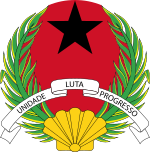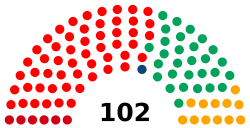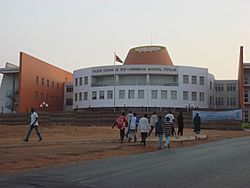National People's Assembly (Guinea-Bissau) facts for kids
Quick facts for kids National People's Assembly of Guinea-BissauAssembleia Nacional Popular da Guiné-Bissau |
|
|---|---|
| 11th Legislature | |
 |
|
| Type | |
| Type | |
| History | |
| Founded | 1973 |
| Leadership | |
|
President
|
Vacant
Since 4 December 2023 |
|
Vice-President
|
Vacant
Since 4 December 2023 |
|
Second Vice-President
|
Vacant
Since 4 December 2023 |
| Structure | |
| Seats | 102 members |
 |
|
|
Political groups
|
|
|
Length of term
|
4 years |
| Elections | |
| Party-list proportional representation | |
|
Last election
|
4 June 2023 |
|
Next election
|
2025 |
| Meeting place | |
 |
|
| Palácio Colinas de Boé, Bissau | |
The National People's Assembly (called Assembleia Nacional Popular in Portuguese) is like the main law-making group in Guinea-Bissau. This country is located in West Africa. The Assembly is where important decisions are made for the nation.
The Assembly has a total of 102 seats. All 102 members are chosen by the people through elections.
Contents
What is the National People's Assembly?
The National People's Assembly is the main law-making body of Guinea-Bissau. It is a "unicameral" body. This means it has only one main group of members, not two separate groups like some other countries.
How Members Are Chosen
The 102 members of the Assembly are elected by the citizens of Guinea-Bissau. They are chosen using a system called Party-list proportional representation. This system helps make sure that different political parties get a number of seats that matches how many votes they received.
What the Assembly Does
The main job of the National People's Assembly is to create and approve laws for Guinea-Bissau. They also discuss important issues that affect the country. The Assembly approves the country's budget, which is like a plan for how the government will spend money. They also check on how the government is doing its work.
Important Elections
Members of the Assembly serve for a term of four years. The most recent election for the Assembly happened on June 4, 2023. During this election, the people of Guinea-Bissau voted for the members who would represent them.
Where the Assembly Meets
The National People's Assembly meets in a building called the Palácio Colinas de Boé. This important building is located in Bissau, which is the capital city of Guinea-Bissau.
Learn More About Guinea-Bissau
- History of Guinea-Bissau
- Politics of Guinea-Bissau
- List of presidents of the National People's Assembly of Guinea-Bissau

